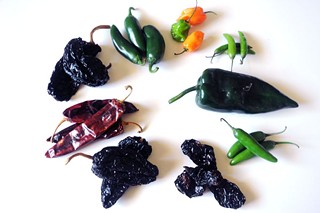Pepper Pairing Primer
There's more to chiles than just the heat
By Mick Vann, Fri., Aug. 26, 2011
When chile-heads get creative, as they so often do at The Austin Chronicle Hot Sauce Festival, they incorporate a wide range of ingredients into their salsas, and the range of fresh and dried chiles they use is huge. Centuries of cultural use have established guidelines for chile use in the kitchen, and many factors apply. The environment in which they were grown (e.g., hotter means spicier, and a drought equals more heat), whether they are green or ripe or fresh or dried, their ratio to one another and with other ingredients, whether they are used raw or cooked, and how they are cooked all shape a chile's use. Generally, the riper the chile, the hotter and sweeter it is; the smaller a pepper is, the hotter it is. Fresh chiles, especially unripe chiles, have a more biting piquancy, while ripe, dried chiles have a complex, fuller, and more rounded and balanced flavor.
The heat of chiles releases best when they're first cooked in a bit of fat or oil, which is why chile pastes are often first quickly sautéed when making salsas; long simmering dilutes individual flavor. It makes sense, then, that fat-free chile salsas usually benefit from the balancing taste of sweet or sour flavors. The skin of green chiles can be bitter and tough, so they are often roasted and peeled before use, softening the vegetal tones and adding a smoky, earthy flavor profile. However, for a cleaner profile, they can be blistered in hot oil before peeling. Dried chiles are usually lightly toasted over a flame or griddle before being rehydrated in water or stock. When you combine chiles in salsas, consider the texture, flavor profile, color, and heat level, as well as whether the heat lingers or dissipates.
Fresh chiles vary widely in heat level, acidity, and flavor, especially regarding their fruitiness and citrus qualities. Jalapeños are used fresh, pickled, and roasted – their taste profile isn't distinctive, so they are often used for texture, sharpness, and background. Serranos have a crisp acidity, a medium-hot heat level, and a vegetal flavor. They are used fresh, roasted, or pickled, and they mate perfectly with tomatoes and cilantro. Poblanos are almost always used roasted in salsas. Their flavor is rich, vegetal, and slightly grassy, with medium heat. A combination of the three with onion, garlic, lime, cilantro, and raw or roasted tomatoes for red sauce or a with bit of avocado or tomatillo for green sauce is the ideal triumvirate for a fresh salsa or salsa base.
Anaheim chile is the sissified sibling of the New Mexico green, which is hotter and has a much more distinctive aromatic, sweet, and earthy flavor: Nothing else tastes like a New Mexican green chile. They are always used roasted in salsas. Pequin and its relatives have a complex taste with fruity, citrusy notes; a slight smoky element reminiscent of toasted corn nuts; and a searing crisp finish, making them ideal as background players. The habanero and its cousins have a floral or tropical fruitiness, distinct complex flavor, and lasting, searing heat, so they marry well with tropical fruits and tomatoes. Thai chiles have a lasting and very spicy finish but little distinct flavor, while cayenne has a sharp pungency with musty floral and haylike notes. Both contribute well as background salsa heaters.
Dried chiles bring complex flavor to red sauces, ideally laying down a rich base flavor accented by fruity notes and finishing with a citrusy, spicy burn. One of the most popular peppers is the chipotle, a smoke-dried jalapeño that produces smoky, sweet flavor with chocolate and tobacco notes. The medium to high heat lingers and is excellent with milder, sweeter dried chiles. Its milder cousin the mora chile adds plum overtones. The ancho is the sweetest and most frequently used dried chile in Mexico, often found as a foundation flavor in salsas. It adds complex tones of coffee, licorice, tobacco, dried plum, and raisin, with lingering mild heat. Its smokier cousin the mulato is less complex, with dried cherry notes. Chile colorado and New Mexico red have distinctive, deep, rich, earthy flavors, with light acidity and hints of cherry and sage. The heat is crisp, clear, and lingering, making them ideal as a base flavor.
The cascabel provides a rich, deep, nutty, slightly acidic flavor with tobacco and tannin notes; the shell's medium-low heat is hotter with ribs and seeds included, especially at the back of the throat. The guajillo offers low to moderate heat, with sweet, rich, smoky, and complex flavors of berry and green tea, as well as a hint of pine or tannin. The pasilla has rich depth and moderate heat. Herbaceous with berry and grape notes and a tiny touch of licorice, it's ideal as a base for salsas to be used with seafood. The chile de árbol is close to cayenne in heat and flavor, leaving a searing, acidic heat on the tip of the tongue. With woody, smoky, and grassy flavors, it makes a nice accent on the finish.
Experiment with the proper ingredients at the correct ratios, taste test, carefully analyze, and adjust to perfection for that ideal flavor and heat combination, and you could be the lucky chile-head holding a coveted trophy when the judges finish.









